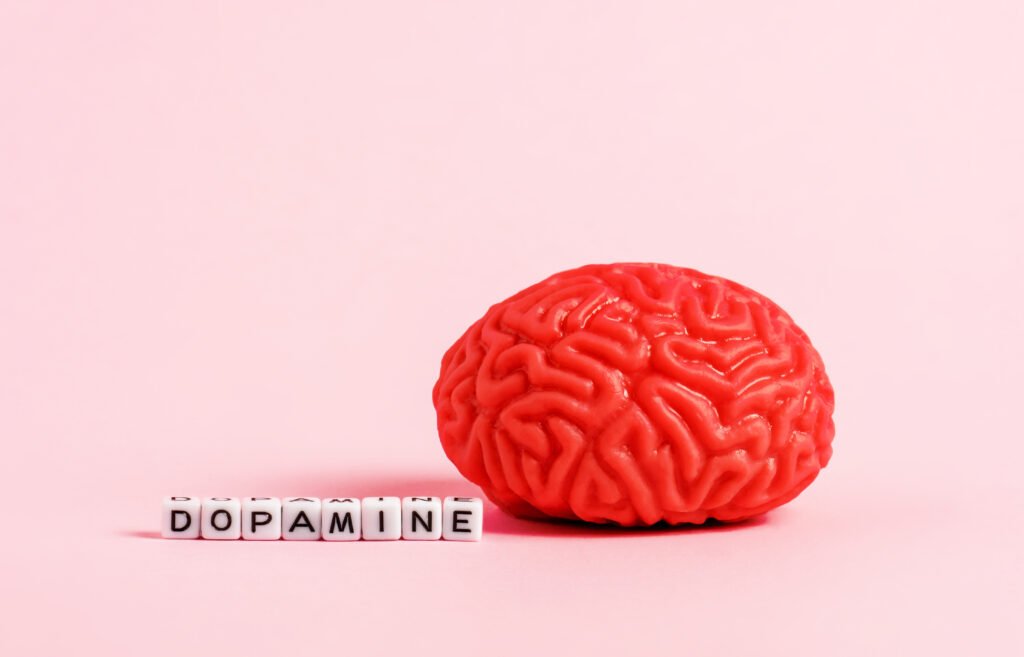Welcome to the journey of understanding how the neurochemical dopamine plays a pivotal role in our ability to focus and enhance productivity. In this introduction, we will embark on a fascinating exploration of the dopamine-driven dynamics within our brains. This is not just a scientific endeavor; it’s a practical quest to help you unlock your full potential.
Understanding the Role of Dopamine in Focus and Productivity
Dopamine: The Neurochemical Catalyst
Dopamine, often referred to as the “feel-good” neurotransmitter, serves as the driving force behind our behaviors, desires, and accomplishments. It’s the molecule responsible for that sense of reward and pleasure we experience when we achieve something or indulge in enjoyable activities. But, what’s its connection to focus and productivity?
The Dopamine-Focus Nexus
Dopamine isn’t just about feeling good; it’s about staying engaged and attentive. When we engage in tasks that trigger dopamine release, our brains become laser-focused. It’s the fuel that powers our ability to pay attention and stay absorbed in what we’re doing. This connection between dopamine and focus forms the cornerstone of our exploration.
The Zen Retreat Revelation
Maria’s story is a testament to the power of dopamine and its impact on our work and lives. Her revelation during a silent Zen Meditation Retreat, where she discovered the transformational potential of dopamine, will leave you inspired and eager to explore how you can harness this neurochemical for your benefit.
The Quest for Improved Focus and Productivity
Why Focus and Productivity Matter
In today’s fast-paced world, the ability to focus and maintain productivity is the key to personal and professional success. Whether you’re aiming to excel in your career, complete a project, or simply accomplish your daily tasks efficiently, the quest for improved focus and productivity is universal.
Our Dopamine-Centric Approach
In our quest for enhanced focus and productivity, we won’t simply seek to avoid distractions or force ourselves to work harder. Instead, we’ll delve into the intriguing world of dopamine and how it can become your most potent tool for hyper-focus. This approach offers a holistic understanding of how our brains function and how we can harness their innate mechanisms to achieve our goals.
As we journey through the subsequent sections, you’ll gain actionable insights and practical techniques to recalibrate your relationship with dopamine, making it a force that propels you forward in your pursuit of peak performance. So, let’s dive deeper into the science of dopamine and its intricate connections.
The Science of Dopamine
In the realm of neuroscience, understanding the intricate workings of dopamine is like deciphering the code to a hidden treasure chest of human behavior and cognition. This section embarks on a journey into the scientific depths of dopamine, uncovering its fundamental role and shedding light on its intriguing connection to addiction and reward-seeking behavior.
Unraveling the Dopamine Neurochemical
The Dopamine Molecule: Nature’s Motivator
Dopamine, chemically known as C8H11NO2, is a neurotransmitter that acts as a powerful motivator within the brain. It plays a pivotal role in our ability to experience pleasure, desire, and reward. This neurotransmitter operates within a complex neural network, where it communicates messages related to movement, motivation, and the perception of pleasure.
Dopamine Synthesis and Release
Dopamine is synthesized within nerve cells from the amino acid tyrosine. Once synthesized, it’s stored in vesicles, awaiting the right signal for release. When an event or experience triggers the brain’s reward system, dopamine is released, creating a sense of pleasure and reinforcing the behavior that led to its release.
Dopamine and Its Link to Addiction and Reward-Seeking Behavior
The Allure of Pleasure: Dopamine and Addiction
One of the most intriguing aspects of dopamine is its involvement in addiction. When we engage in activities that release dopamine, such as eating delicious food or winning a game, our brains remember the experience and motivate us to repeat it. However, this reward-seeking behavior can also lead to harmful addictions, including substance abuse and compulsive behaviors.
The Dopamine Reward Pathway
Within the brain, there’s a well-defined reward pathway associated with dopamine release. It includes areas such as the nucleus accumbens, ventral tegmental area (VTA), and prefrontal cortex. When this pathway is activated, it reinforces the behavior that led to the pleasurable experience. This mechanism is essential for survival but can also be exploited by addictive substances and behaviors.
The Paradox of Desire and Discontent
Dopamine’s role in reward-seeking behavior creates a paradox. While it drives us to seek pleasure and rewards, it can also lead to a perpetual state of wanting more. This constant desire can result in feelings of discontent, as we continuously strive for the next dopamine-inducing experience.
Understanding the science behind dopamine provides a foundation for the exploration of how we can harness its power to enhance focus and productivity, a journey we will embark on in the following sections. As we dive deeper into the intricate web of dopamine and its effects on our brain, you’ll gain valuable insights into the mechanisms that drive our behaviors and desires.
Re-sensitizing to Dopamine for Enhanced Focus
In the ever-evolving quest for improved focus and productivity, one of the key elements to consider is the fascinating world of dopamine sensitivity. This section delves into the concept of re-sensitizing ourselves to dopamine and its crucial role in achieving heightened focus and optimal performance.
Rethinking the Notion of Dopamine Detox
The Misconception of Dopamine Detox
Dopamine detoxing has become a buzzword in recent times, often associated with taking radical breaks from stimulating activities. However, the idea of completely detoxing from dopamine is a misconception. Dopamine is a vital neurochemical, and we can’t function without it. Instead of detoxing, the goal is to recalibrate our sensitivity to it.
The Real Challenge: Sensitivity Calibration
The crux of the matter lies in our sensitivity to dopamine. Think of it as a volume knob for your brain’s reward system. If the knob is turned too high, you’ll require excessive stimulation to feel rewarded. But if it’s finely tuned, even subtle rewards can capture your attention. So, the real challenge is to recalibrate this sensitivity.
The Importance of Reward Sensitivity
The Power of Reward Sensitivity
Reward sensitivity determines how much stimulation is needed to activate your brain’s reward system. Low sensitivity means you’ll need a lot of stimulation to focus, while high sensitivity allows you to find reward in even mundane tasks. It’s akin to adjusting the lens through which you perceive the world.
Dopamine as the Reward Indicator
Dopamine plays a pivotal role as the indicator of rewards. When you engage in activities that produce dopamine, your brain interprets them as rewarding. Consequently, you’re more likely to continue those activities. This is why understanding how dopamine sensitivity works is essential for enhancing focus and productivity.
Resetting Your Dopamine Sensitivity: Methods and Techniques
The Journey to Reset Sensitivity
Re-sensitizing to dopamine is a practical endeavor that can yield significant benefits for your ability to focus. It’s not about depriving yourself but rather about recalibrating your brain to find reward in meaningful tasks. Here are some methods and techniques to reset your dopamine sensitivity:
Mindful Consumption
- Engage in activities mindfully, paying close attention to the rewards they offer.
- Reflect on the value and satisfaction derived from each task to reset your brain’s reward system.
Incremental Challenges
- Gradually increase the difficulty of tasks to maintain a sense of achievement and reward.
- This incremental approach helps you build sensitivity to smaller rewards.
Dopamine Fasting
- Periodically limit your exposure to highly stimulating activities, such as social media or video games.
- By temporarily reducing these stimuli, you can recalibrate your sensitivity.
Mindful Breaks
- Use breaks as opportunities to reset dopamine by engaging in calming activities.
- A short meditation session or a mindful walk can be more effective than a high-stimulation break.
Re-sensitizing to dopamine is a journey of fine-tuning your brain’s reward system. By understanding and implementing these techniques, you’ll be on the path to enhancing your focus and productivity. As we continue our exploration in the following sections, you’ll discover more strategies to make dopamine your ally in achieving flow and peak performance.
Taking Boring Breaks: A Dopamine Reset Strategy
In the relentless pursuit of enhancing focus and productivity, an intriguing strategy emerges – the art of taking “boring” breaks. This section explores the concept of using seemingly uneventful moments to reset your dopamine levels, ultimately bolstering your ability to stay on task and achieve peak performance.
The Pitfalls of Overstimulating Breaks
The Temptation of Overstimulation
When it comes to breaks, many of us succumb to the allure of overstimulation. We grab our smartphones and dive into a sea of constant novelty, seeking the next dopamine hit. However, this approach can lead to a counterproductive cycle. Overstimulating breaks can leave us even more distracted and less able to focus when we return to work.
The Role of Dopamine Desensitization
Overstimulating breaks contribute to dopamine desensitization. The more intense and frequent the stimulation, the more our dopamine receptors become accustomed to it. This means we need increasingly stimulating activities to capture our attention, making it harder to find satisfaction in mundane tasks.
Staring at a Wall: The Power of Boring Breaks
Rediscovering the Mundane
Contrary to the fast-paced, hyper-stimulating breaks, there is power in embracing the mundane. One effective strategy is simply staring at a wall. This might sound uneventful, but it’s a deliberate attempt to reduce external stimuli and reset your dopamine receptors.
How Wall Staring Works
- Find a quiet space, free from distractions.
- Sit or stand comfortably.
- Direct your gaze to a plain wall or a neutral object.
- Allow your mind to wander without a specific goal or task.
While it may seem odd, this practice encourages your brain to recalibrate its sensitivity to dopamine. It’s like hitting the reset button on your reward system.
Other Effective Techniques for Resetting Dopamine
Exploring Dopamine-Reset Techniques
Staring at a wall is just one method among many for resetting your dopamine sensitivity. Here are a few other effective techniques to consider:
Mindful Breathing
- Take a few minutes to focus on your breath.
- Breathe in deeply, counting to four, then exhale for a count of four.
- This practice calms your mind and allows you to reset.
Short Naps
- A quick power nap of 10-20 minutes can refresh your mind.
- It helps clear out mental clutter and rejuvenates your focus.
Mindfulness Meditation
- Spend a few minutes in mindfulness meditation.
- Focus on your breath or a specific sensation to reset your brain’s reward system.
Light Exercise
- Engage in light physical activity, such as stretching or a short walk.
- Physical movement can boost dopamine and clear mental fog.
By integrating these techniques into your daily routine, you can gradually re-sensitize your brain to the joys of focused work. Boring breaks may seem counterintuitive, but they can be the key to unlocking heightened productivity and a deeper sense of satisfaction in your tasks. In the next sections, we’ll explore additional strategies to fine-tune your relationship with dopamine for peak performance.
Inhabiting the In-Between Moments
In the fast-paced world we live in, our days are filled with in-between moments. These are the pockets of time between scheduled activities, the minutes spent waiting for a friend to arrive, or the hours of commuting to and from work. While these moments may seem inconsequential, they hold the key to enhancing your dopamine sensitivity and, in turn, your focus and productivity.
The Habit of Smartphone Addiction
The Smartphone Dilemma
One of the major hurdles to inhabiting the in-between moments is our deep-seated addiction to smartphones. These devices, while incredibly useful, also have a knack for hijacking our attention. We often turn to them during any free moment, from checking social media to mindlessly scrolling through news feeds.
The Dopamine Connection
Smartphones trigger dopamine releases through notifications, likes, and messages. This constant stimulation keeps our dopamine receptors on high alert, making it challenging to appreciate the quieter moments in life. Over time, this addiction can lead to a decrease in sensitivity to natural rewards, like the satisfaction of completing a task or enjoying a peaceful moment of reflection.
Leveraging Moments of Waiting and Commuting
Rediscovering the Value of Waiting
Instead of reflexively reaching for your smartphone during moments of waiting, consider a different approach. These in-between moments can be used as opportunities to reset and re-sensitize your brain to dopamine. Here are some practical strategies:
Mindful Observation
- Take a moment to observe your surroundings.
- Notice the details you might usually overlook.
- Engaging your senses in this way can stimulate a mild dopamine response.
Deep Breathing
- Practice deep breathing exercises during your commute.
- Inhale slowly for a count of four, hold for four, then exhale for four.
- This technique calms the mind and can enhance focus.
Transforming Commuting Time
Your daily commute can also become an opportunity for dopamine re-sensitization. Instead of zoning out or fretting over traffic, consider these strategies:
Audiobooks and Podcasts
- Listen to audiobooks or podcasts that interest you.
- Engaging with informative or inspiring content can trigger a positive dopamine response.
Mindful Commuting
- Use your commute as a time for mindfulness.
- Focus on your breath and surroundings rather than ruminating on work stress.
How Being Present Enhances Dopamine Sensitivity
The Power of Presence
Ultimately, inhabiting the in-between moments is about being present. When you fully engage with your surroundings and your thoughts, you give your brain a chance to reset and recalibrate. Being present enhances your sensitivity to the natural rewards that life offers, helping









